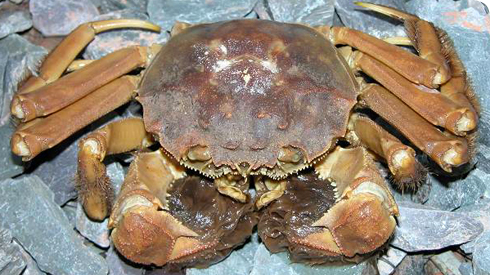Invasive species
Increasing numbers of species are colonising regions of the world where they do not naturally occur. This is often due to human activity. Some species are transported to new areas in agricultural products, while others are introduced deliberately, to control a ‘pest’.
Whether deliberate or accidental, introducing an alien species to a region often causes conservation problems. It does not have any natural predators in its new environment so its numbers can grow out of control, sometimes at huge cost in both ecological and financial terms.
Here are some of the invasive species that Museum scientists study.
-

Argulus japonicus - 27/04/2010
Argulus japonicus is a fish louse that parasitises a wide range of freshwater fish hosts. Originally from the Far East, today is widespread after being transported around the world with stocks of ornamental fish. Find out more.
-

Azolla filiculoides (water fern) - 15/11/2010
Azolla filiculoides is a tiny invasive fern that has spread around the world, but can be put to good use. It thrives in nutrient-rich ponds and ditches, where it forms potentially damaging thick mats of foliage. Azolla can be a useful fertiliser, thanks to a nitrogen-fixing alga that lives in it, and so is often used in paddy fields to improve rice yields. Take a closer look at this floating fern.
-

Corella eumyota (orange-tipped sea squirt) - 29/07/2010
The orange-tipped sea squirt can attach to almost anything - piers, ropes, even other sea squirts. It has hitch-hiked its way to most parts of the world on ship hulls and in shipments of mussels and oysters. Find out more about this invasive filter-feeder, and how it is damaging native fauna and flora.
-

Eriocheir sinensis (Chinese mitten crab) - 11/03/2010
The Chinese mitten crab has spread far beyond its native range and is considered one of the world’s worst invasive alien species. Find out more about this 'furry' crab, including why it poses such a threat to native ecosystems and how our scientists are helping to find a way of controlling alien populations.
-

Parkinsonia aculeata - 03/12/2010
Parkinsonia aculeate is an attractive wild plant that grows throughout the Americas, but has become invasive in Australia, Africa and the Caribbean. It has intricate yellow flowers and photosynthetic branches that make it a popular garden plant and help it survive in semi-arid conditions. Find out more about this pretty tree and how every part of it can be put to good use.
-

Pulvinaria regalis - 13/08/2010
The horse-chestnut scale insect is a true bug. It feeds on tree sap by sucking it up through modified mouthparts. Since being introduced into Europe from Asia accidentally it has become a widespread nuisance, particularly in urban areas. Find out more about Pulvinaria regalis and how it produces a characteristic mottled affect on tree trunks.
-

Steatoda nobilis (false widow spider) - 18/04/2010
Steatoda nobilis (the false widow spider) is known for being the UK's most venomous spider, however its venom does not usually have long-lasting effects on humans. It is strongly synanthropic (lives in close association with humans) and typically lurks high off the ground in dark corners. Find out more about this species.
-

Arocatus longiceps (plane tree bug) - 11/12/2010
Arocatus longiceps is a true bug that was first spotted in Britain in 2006. By 2007 it was common here in the Museum’s wildlife garden, but its identity remained a mystery for months afterwards. Find out more about this insect and why it was difficult to identify, and follow its travels across the globe.
-

Cameraria ohridella (horse-chestnut leaf miner) - 25/09/2010
Cameraria ohridella is a small leaf-mining moth that lives on horse-chestnut trees. Its larvae turn leaves prematurely brown and can reduce the trees’ conker crop. No-one knows when the moth first appeared, but it was discovered over 25 years ago and has become widespread in the last decade. Find out where you might spot this tiny moth and its distinctive leaf mines.
-

Ips typographus (8-toothed spruce bark beetle) - 29/12/2010
Ips typographus, the 8-toothed spruce bark beetle, lives on Christmas trees. Its larvae burrow into the bark, but it causes most damage by introducing a fungus that can within a few weeks, turn the wood blue, reducing the commercial value of the tree and eventually kill it. Discover more about the boring methods of this tactical beetle.
-

Leptoglossus occidentalis (western conifer-seed bug) - 26/11/2010
Leptoglossus occidentalis is an invasive insect that has spread from North America to Europe in the last 10 years. It is an agricultural pest that feeds on pine trees and can cause significant seed loss in commercial tree crops such as the Douglas fir. Find out more about this 'leaf-footed' bug.
-

Sminthurus viridis (lucerne flea) - 28/09/2010
Sminthurus viridis is a springtail species that is native to Europe but, since its introduction to the southern hemisphere, has become an agricultural pest. This tiny animal can decimate crops such as clover and lucerne as numbers reach a million per square metre. Discover more about the life of the lucerne flea, and how recent DNA studies are helping scientists explore the springtail's evolutionary relationship with insects.

